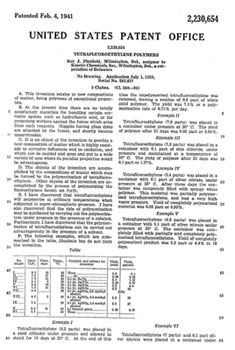 Teflon is yet another product invented entirely by mistake. Roy Plunkett, a research chemist at Dupont, was experimenting with synthesizing new types of refrigerant gas when he accidentally produced Teflon.
Teflon is yet another product invented entirely by mistake. Roy Plunkett, a research chemist at Dupont, was experimenting with synthesizing new types of refrigerant gas when he accidentally produced Teflon.
On the morning of April 6, 1938, Plunkett and his technician assistant, Jack Rebok, were setting up for an experiment with the refrigerant gas tetrafluoroethylene (TFE). Plunkett hoped to make a refrigerant by reacting hydrochloric acid with TFE. Plunkett had made a hundred pounds of the gas, to be sure to have enough for all his chemical tests, and for toxicological tests as well. He stored the gas in metal cans with a valve release. Plunkett kept the cans on dry ice, to cool and liquefy the TFE gas. One of the pressurized cylinders of TFE that they had filled failed to discharge when its valve was opened. They weighed the tank to see if the gas had leaked out but it was still full. They tried to unclog the valve but still nothing came out. Rebok suggested sawing the tank in half to see what had gone wrong. Despite the danger of explosion, Plunkett agreed. Inside the cylinder they found a white power. The gas had solidified through polymerization.
Curious, Plunkett immediately began running tests on this new substance. He had to be sure it was viable so he conducted an experiment to reproduce the substance. The experiment was a success and Teflon was created. DuPont applied for a patent on July 1, 1939. In 1941, Patent #2230654 was granted for Tetrafluoroethylene polymers
Teflon is considered the most slippery material in existence. It is insoluble in almost everything. It doesn’t char or melt in extreme heat. Teflon doesn’t rot, swell, mildew, mold or degrade in sunlight. Because of the versatile properties of Teflon, it has uses in almost every industry including communications, aerospace, and architecture. Today, Teflon is common in households and used to refer to the non-stick coating on cookware.
Roy Plunkett has been recognized for his achievement. He was inducted to the Plastics Hall of Fame in 1973 and the Inventors Hall of Fame in 1985.

